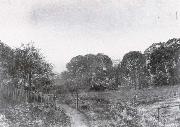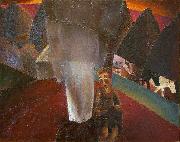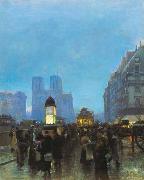
Oil On
Canvas, Real Flavor of Old Masters
|
Atkinson Grimshaw
|
|||
|
|
|||
| British 1836-1893 Atkinson Grimshaw Gallery Grimshaw's primary influence was the Pre-Raphaelites. True to the Pre-Raphaelite style, he put forth landscapes of accurate color and lighting, and vivid detail. He often painted landscapes that typified seasons or a type of weather; city and suburban street scenes and moonlit views of the docks in London, Leeds, Liverpool, and Glasgow also figured largely in his art. By applying his skill in lighting effects, and unusually careful attention to detail, he was often capable of intricately describing a scene, while strongly conveying its mood. His "paintings of dampened gas-lit streets and misty waterfronts conveyed an eerie warmth as well as alienation in the urban scene." Dulce Domum (1855), on whose reverse Grimshaw wrote, "mostly painted under great difficulties," captures the music portrayed in the piano player, entices the eye to meander through the richly decorated room, and to consider the still and silent young lady who is meanwhile listening. Grimshaw painted more interior scenes, especially in the 1870s, when he worked until the influence of James Tissot and the Aesthetic Movement. On Hampstead Hill is considered one of Grimshaw's finest, exemplifying his skill with a variety of light sources, in capturing the mood of the passing of twilight into the onset of night. In his later career this use of twilight, and urban scenes under yellow light were highly popular, especially with his middle-class patrons. His later work included imagined scenes from the Greek and Roman empires, and he also painted literary subjects from Longfellow and Tennyson ?? pictures including Elaine and The Lady of Shalott. (Grimshaw named all of his children after characters in Tennyson's poems.) In the 1880s, Grimshaw maintained a London studio in Chelsea, not far from the comparable facility of James Abbott McNeill Whistler. After visiting Grimshaw, Whistler remarked that "I considered myself the inventor of Nocturnes until I saw Grimmy's moonlit pictures."[9] Unlike Whistler's Impressionistic night scenes, however, Grimshaw worked in a realistic vein: "sharply focused, almost photographic," his pictures innovated in applying the tradition of rural moonlight images to the Victorian city, recording "the rain and mist, the puddles and smoky fog of late Victorian industrial England with great poetry." Some artists of Grimshaw's period, both famous and obscure, generated rich documentary records; Vincent Van Gogh and James Smetham are good examples. Others, like Edward Pritchett, left nothing. Grimshaw left behind him no letters, journals, or papers; scholars and critics have little material on which to base their understanding of his life and career. Grimshaw died 13 October 1893, and is buried in Woodhouse cemetery, Leeds. His reputation rested, and his legacy is probably based on, his townscapes. The second half of the twentieth century saw a major revival of interest in Grimshaw's work, with several important exhibits of his canon. | |||
|
|
|||
|
|
Twilight new16/Atkinson Grimshaw-773468.jpg Painting ID:: 44618 Visit European Gallery |
mk174 1869 Oil on board 39.4x53.4cm | |
Height Width |
INS/CM |
||
|
X |
|
||
|
|
|||
|
Frits Van den Berghe
|
|||
|
|
|||
| (3 April 1883 - 22 September 1939) was a Belgian expressionist painter. He was born at Ghent. Like his friends Constant Permeke and Gustave De Smet, he first adopted the late-impressionist style of Emile Claus, but converted to expressionism during World War I. | |||
|
|
|||
|
|
Twilight new24/Frits Van den Berghe-448756.jpg Painting ID:: 81962 Visit European Gallery |
Date 1923-1924 Medium Oil on canvas Dimensions 106 x 131.5 cm (41.7 x 51.8 in) cjr | |
Height Width |
INS/CM |
||
|
X |
|
||
|
|
|||
|
Edmund Tull
|
|||
|
|
|||
| (1870 - 1911) was a Hungarian artist born at Szekesfeherver. He was educated at Budapest, Milan, and Paris, being in the last-named city a pupil of J. P. Laurens and of B. Constant. His first work, "The Cathedral of Notre Dame," attracted attention at the exposition in Budapest in 1896, while his etchings are especially valued in London and Vienna. His best-known works are: "Peasant Mowing," "A Lane in Dort," and "The Island of Capri," in the historical art museum of Budapest; and "The Smithy," owned by Archduchess Isabella. | |||
|
|
|||
|
|
Twilight new24/Edmund Tull-438464.jpg Painting ID:: 82526 Visit European Gallery |
. Oil on canvas, 81x65 cm. Paris, 1897. Date 1897(1897) cjr | |
Height Width |
INS/CM |
||
|
X |
|
||
|
|
|||









